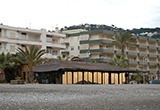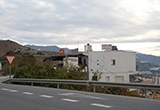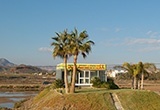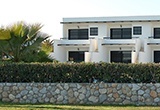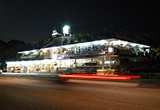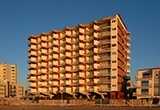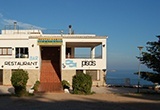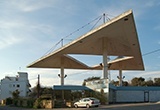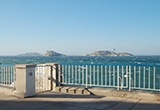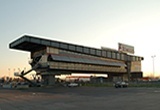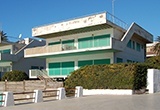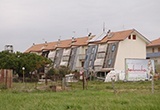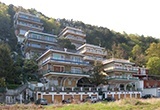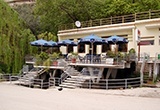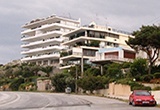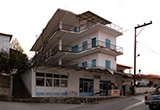AN ITINERANT SURVEY FROM GIBRALTAR TO THE DARDANELLES
The collection we present here is the result of a journey undertaken along the European section of the Mediterranean coastal road, from the Cape of Gibraltar to the Dardanelle Straits. Throughout two trips, in the winter of 2005 and the spring of 2006, armed with a road map, a camera and a notebook, we travelled by car across this neo-urban territory constituted by the Mediterranean coast. The resulting catalogue encompasses some fifty constructions which represent a manifesto for an uninhibited and richly detailed architecture, concerned above all with a certain “art de vivre”.
1 - A SATURATED ARCHITECTURAL FIELD
Iconophagy
Architecture as it is currently developing, in the form of a cultural consumer product, neglects the considerations which should strive to constitute a living environment generous in terms of habitability, as well as semantically stimulating.
We are simultaneously swamped by the mediocrity of the productions on our doorstep, and bombarded with icons constructed on the other side of the planet, all fields saturated with signals of architectural creativity. Paradoxically, this all-out creativity tends only to operate within an ultimately quite limited spectrum where the logo and social presentation take precedence. We are thus witnessing a veritable ideological ground swell intended to reduce architecture to the level of a stereotypical consumer product, packaged and marketed, rather than as an artefact conceived in relation to necessity and to quality of life. The field of architectural problematics is becoming narrower, the fundamental aspects of a project are no longer discussed, supplanted in the briefs by scholarly rhetoric describing the design process, the motif of the facades, the alignment of the windows, the composition of the packaging, and of course energy consumption, the new religion on the altar of which all other aspirations are sacrificed. The instant comprehension of a project thus becomes the dominant criterion, and this iconophilia parasitizes, indeed often replaces, any more considered reflection on functioning and atypical usages. In the final analysis, by constant insistence on the primacy of the visual and the image, architects are gradually losing any hold over project consistency (location, typologies, functioning) as this becomes an area reserved for the more political field of development, planning and standardisation.
The pleasure of discovery
The journey related herein was taken as an antidote (in a personal capacity at least) to this situation.
For us, exploration remains, indeed, the essential field in which to truly experience places and things. The understanding of remarkable and identified works remains, certainly, an exciting field, yet boils down to the distant apprehension of locations which, in the vast majority of cases, will only ever be perceived through documents and depictions which are necessarily partial. When Jacques-Germain Soufflot, tipped off by an obscure Neapolitan actor, discovers Paestum by boat, when Reyner Banham rewrites the history of Santa Monica Pier, when Rem Koolhaas sees in a commercial district of Lagos built from breezeblocks and satellite dishes a vision of the dematerialised city of the future, this is the experience of discovery, and it is this narrative, this emotion felt and perceived in the moment, which for us is the foundation of all reflection.
Report and collection
The journey we undertook extends along the Mediterranean coast, from the Cape of Gibraltar to the Dardanelle Straits. This territory, chosen for its geographical unity, is also characterised by a specific form of urbanity. Constructed in a quasi-continuous manner, it is indeed emblematic of an intangible urban organisation in which buildings are often perceived in isolation. This dispersion, and the means of locomotion arising therefrom, thus compel us to apprehend the built locations as a series of assemblies of unitary elements, and no longer as a continuous and malleable substance. We, therefore, travelled some 8,000 km along the coastal road in search of constructions which would light within us the little spark of pleasure only to be found in built locations where materials, activities and landscape seem engaged in dialogue. The selection we have used is thus similar to the constitution of a collection, embracing constructions which may be banal or extraordinary but whose formal configuration is always based on mechanisms where generosity supplants pomp.
2 - A SPECIFIC COLLECTION
Série B architecture
It may have been more advantageous, of course, to fill our catalogue with fifty emblematic recent constructions, but, since there is little express focus on such supposedly scholarly architecture, it disappears quite quickly from the field of study, so tiny is its presence in what are rather generic territories. This rarefaction, induced by the methodology we have adopted, also serves our purpose in that it emphasises an architecture which could be described as Série B, to paraphrase Martin Steinmann and his second-line architecture. Série B architecture represents the wave (with heroic architecture as the spume) of the deep renewal of the urban fabric. This category of architectures often commandeers, in highly pragmatic fashion, innovations in the art of construction driven by pioneers and, in its multitude, thus institutes these transformations more permanently. Such appropriation thereby constitutes a form of plebiscite of solutions appropriate to economic, constructive or planning problematics. Série B architecture is thus deployed in a less rhetorical field, and more open to the reproduction, transformation and deformation of existing models.
An idiomatic architecture
A few years ago, during a trip to Los Angeles, keen to discover the many modernist masterpieces dotted around the hills, we were struck by the charm and intelligence of the many residential complexes, condominiums, and other courtyard-based buildings which constitute, within its densest areas at least, the everyday reality of the Californian metropolis. Thinking ourselves admirers of Eames, Neutra, Schindler, we were actually in love with a very Californian lifestyle. These inventive and refined architects had certainly created genuine works, but nourished by a vernacular soil which constituted (as we experienced in situ) the kernel of our initial attraction. The risk of immoderate consumption of cosmopolitan references is the confusion of style and idiom ; while the first may easily be exported, the second often requires a conceptual adaptation which will transform an imported product into a situated construction. Our California is the Mediterranean, and the exploration on which we embarked, as a continuation of this discovery, has developed our taste for the idiom rather than the unique piece.
From construction to situation : an architecture of resistance
The unease we feel at the flood of scattered references often stems from their a-temporal and a-contextual apprehension. The effective paradox of such a perception is that it downplays that which will ultimately transform any isolated edifice into a perennial and relevant constructed location, that is, its ability to resist time and the symbolic exhaustion of the fashion system. In search of an inexhaustible delight, our choice, therefore, focused on located and dated constructions, to duly confirm the permanence of the qualities we feel to be essential : concision, hospitality or scalability.
Sources of complexity : from the banal to the extra-normal
This resistance, more symbolic than physical, is of course difficult to evaluate in the present. However, what underpins our practice is indeed the essential connection between the town as it is constructed, with or without architects, and the invention of projects, which, even where they proceed from an overly scholarly approach, are designed to integrate into - perhaps actually by standing out from - an existing structure.
And if architecture should be conceived, as we feel it should, regarding that which already exists, or if, at least, the existing can serve as a matrix for the development of the project, it is essential that this reference, these commonplaces, be identified as such, and this is one of the objectives of our catalogue. Finally, if the beauty of architecture is to be found in the fabric of references it weaves with the existing constructions, whether close or distant in time and space, it remains vital that this common idiom should never constitute a constraint in terms of the inherent qualities the project must offer.
In this sense, and to return to a theme addressed earlier, the selection we have made focuses on projects which are inventive by necessity rather than by obligation. The ambition of our catalogue is, then, to highlight the coexistence of the banal and the extraordinary as dictated by specific situations, as well as within a single construction.
Pleasure and frivolity
If we have tried to specify the diverse inspirations for our collection, this has also served to conceal the culpability of a choice guided by the principle of pleasure. But it is perhaps appropriate to explain how this is to be understood when speaking of architecture and its means of conception.
Pleasure, for us, is above all a shared feeling, and in urban locations, it is, therefore, the aptitude of any development to be intensely frequented and inhabited ; pleasure or enchantment, of course, arises from the generosity deployed by an architecture towards its everyday inhabitants and what it offers in terms of practicalities and quality of life ; towards a wider public, pleasure is also a matter of concision, or the ability of an architecture not to disperse its effects and to offer renewed experiences while giving little away ; pleasure is, finally, the idea of frivolity not as a foundation, since, except for a few singular developments, this quality is scarcely compatible with the idea of perennity, but as an act of coquetry, an ornamental strategy proclaimed as such.


